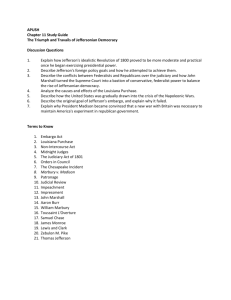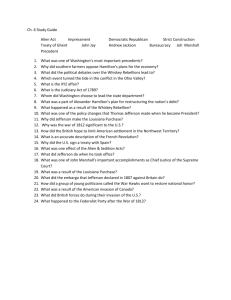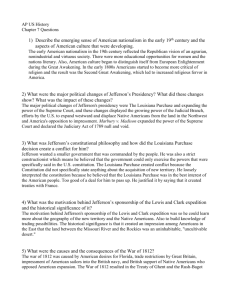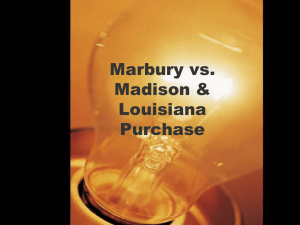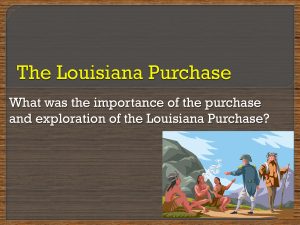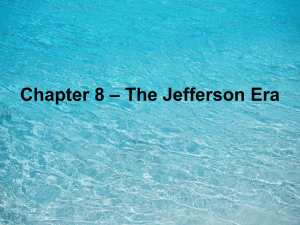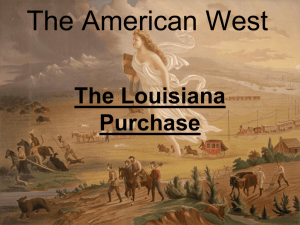ch. 8 powerpoint notes
advertisement
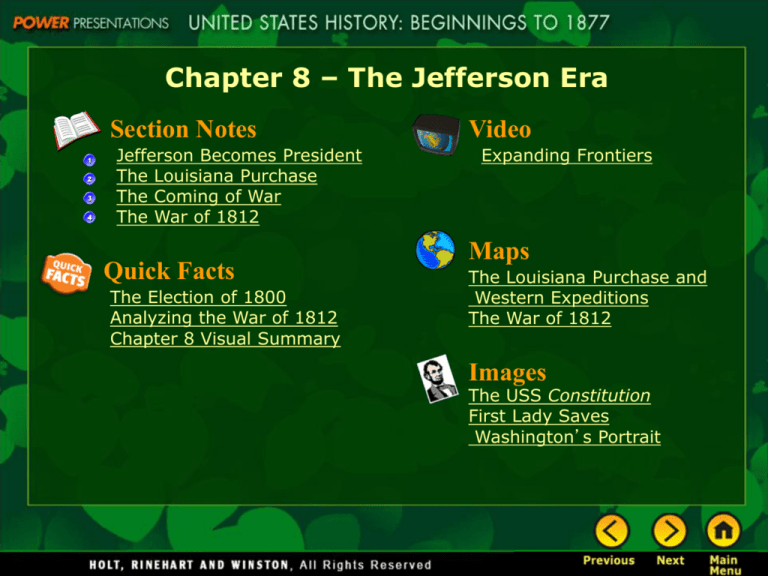
Chapter 8 – The Jefferson Era Section Notes Jefferson Becomes President The Louisiana Purchase The Coming of War The War of 1812 Quick Facts The Election of 1800 Analyzing the War of 1812 Chapter 8 Visual Summary Video Expanding Frontiers Maps The Louisiana Purchase and Western Expeditions The War of 1812 Images The USS Constitution First Lady Saves Washington’s Portrait Jefferson Becomes President The Big Idea Thomas Jefferson’s election began a new era in American government. Main Ideas • The election of 1800 marked the first peaceful transition in power from one political party to another. • President Jefferson’s beliefs about the federal government were reflected in his policies. • Marbury v. Madison increased the power of the judicial branch of government. Main Idea 1: The election of 1800 marked the first peaceful transition in power from one political party to another. • Federalists John Adams and Charles C. Pinckney ran against Democratic-Republicans Thomas Jefferson and Aaron Burr. • Jefferson and Burr tied, with 73 electoral votes each. • The House broke the tie by selecting Jefferson to be president; Burr became vice president. • The tie led to the passage of the Twelfth Amendment, which provided for a separate ballot for president and vice president in the next election. Parties and Beliefs Adams and the Federalists • Rule by the wealthy class • Strong federal government • Emphasis on manufacturing • Loose interpretation of the Constitution • British alliance Jefferson and the Democratic-Republicans • Rule by the people • Strong state governments • Emphasis on agriculture • Strict interpretation of the Constitution • French alliance Main Idea 2: President Jefferson’s beliefs about the federal government were reflected in his policies. • Democratic-Republican–controlled Congress helped put his republican ideas into practice. – Allowed the hated Alien and Sedition Acts to expire. – Lowered military spending. – Got rid of domestic taxes. • Believed main functions of federal government were – Protecting the nation from foreign threats. – Delivering mail. – Collecting customs duties. • Kept some Federalist ideas, like Bank of the United States. Main Idea 3: Marbury v. Madison increased the power of the judicial branch of government. Background • William Marbury appointed justice of peace by President Adams just before he left office. • Marbury’s commission was not delivered; Jefferson took office. • Marbury sued Jefferson administration to get his commission. Supreme Court Ruling • The law Marbury based his claim on was unconstitutional—Judiciary Act of 1789. • Ruled that the Supreme Court did not hear cases like this one, according to the Constitution; thus, the law that Marbury used was unconstitutional. Importance of Judicial Review • Chief Justice John Marshall wrote Court’s opinion in Marbury v. Madison. • Ruling established judicial review—Court’s power to declare an act of Congress unconstitutional. • Made judicial branch equal to other two branches of government. The Louisiana Purchase The Big Idea Under President Jefferson’s leadership, the United States added the Louisiana Territory. Main Ideas • As American settlers moved West, control of the Mississippi River became more important to the United States. • The Louisiana Purchase almost doubled the size of the United States. • Expeditions led by Lewis, Clark, and Pike increased Americans’ understanding of the West. Main Idea 1: As American settlers moved West, control of the Mississippi River became more important to the United States. • Thousands of Americans had settled between the Appalachians and the Mississippi by 1800s. • Kentucky, Tennessee, and Ohio were admitted as states. • Settlers depended on the Mississippi and Ohio rivers to move products east. • Jefferson worried about foreign control of New Orleans and Louisiana. – Americans depended on the river, which could be disrupted if a foreign power shut down access to New Orleans. Louisiana Spanish Control • Spain controlled both New Orleans and Louisiana—land stretching from Mississippi River to Rocky Mountains. • Spain gave land to France in treaty. French Control • French leader Napoléon wanted to rebuild France’s empire in North America. • Rebellion in French colony of Haiti, in the Caribbean, ended Napoléon’s dream in 1802. Main Idea 2: The Louisiana Purchase almost doubled the size of the United States. • Jefferson sent ambassador to France to try to buy New Orleans. • The French offered to sell all of Louisiana. – Napoléon had wanted to set up a North American empire, but a revolt in Haiti ruined those plans. • Price was $15 million. • Louisiana Purchase approved by Senate on October 20, 1803. • Nearly doubled size of United States. Main Idea 3: Expeditions led by Lewis, Clark, and Pike increased Americans’ understanding of the West. Lewis and Clark Expedition • Expedition to explore the Louisiana Purchase. • Led by Meriwether Lewis and William Clark. • Included 50 skilled frontiersmen. • Began near St. Louis on May 14, 1804. • Reached the Pacific Ocean in November, 1805. Contact with Native Americans Lewis used interpreters to talk to leaders of each of the peoples they met. Told them United States now owned land on which Native Americans lived. Relied on goodwill of the peoples they met. - Given food by Shoshone, Nez Percé, and others. Sacagawea, a Shoshone woman, served as a guide and interpreter. Pike’s Exploration • Zebulon Pike, an army officer, led another expedition to the West in 1806. • Explored area near Louisiana Territory’s western border with New Spain • Headed into Rocky Mountains in present-day Colorado – Traveled into Spanish lands and was arrested – When finally released, still praised the opportunities for doing business with the Spanish • Pike’s report offered Americans their first description of the Southwest. The Coming of the War The Big Idea Challenges at home and abroad led the United States to declare war on Great Britain. Main Ideas • Violations of U.S. neutrality led Congress to enact a ban on trade. • Native Americans, Great Britain, and the United States came into conflict in the West. • The War Hawks led a growing call for war with Great Britain. Main Idea 1: Violations of U.S. neutrality led Congress to enact a ban on trade. • Overseas trade was profitable but risky. – Barbary pirates, along the coast of Africa, would capture ships. – Attacks continued until the United States sent the USS Constitution and other warships to stop the pirates. • British and French tried to stop the United States from aiding the other while they were at war in 1803. • British stopped American merchant ships to search for British sailors who had run away from British navy. – British sailors were forced to return and sometimes U.S. citizens were taken by accident. – British ship Leopard stopped U.S. Navy ship Chesapeake and took sailors by force. – Attack on Chesapeake stunned Americans. The United States’ Response Embargo Act Non-Intercourse Act • Embargo Act passed in 1807, banning trade with all foreign countries to punish Britain and France • Congress replaced unpopular Embargo Act with Non-Intercourse Act in 1809 • Devastated American merchants, who lost much money without trade • Banned trade only with Britain, France, and their colonies • Damaged Jefferson and strengthened Federalists • U.S. trade would resume with first side to stop violating American neutrality • Had little effect on Britain and France • Law was no more successful than Embargo Act Main Idea 2: Native Americans, Great Britain, and the United States came into conflict in the West. Conflict Over Land • British and Native Americans clashed with American settlers over land in the West. • British agents armed Native Americans along western frontier. Tecumseh Resists U.S. Settlers • Tecumseh, a Shawnee chief, emerged as leader. • Hoped to unite Native Americans of northwestern frontier, the South, and the eastern Mississippi Valley. The Battle of Tippecanoe • Tecumseh founded village near Tippecanoe and Wabash rivers in Indiana Territory. – Tecumseh was a brilliant speaker and leader. – He wanted to unite the Native Americans to resist settlers. • Governor William Henry Harrison warned Tecumseh not to resist power of the United States. • Harrison led army in attack on village in 1811. – Was worried that with British backing, Tecumseh could be a serious threat to U.S. power in the West. • U.S. forces won Battle of Tippecanoe, and Tecumseh fled to Canada. Main Idea 3: The War Hawks led a growing call for war with Great Britain. War Hawks • Evidence of British support for Tecumseh inflamed Americans. • Some young members of Congress from the South and West, called War Hawks, demanded war against Britain. • They were angered by British trade restrictions and wanted to invade Canada for more land to settle. The Opposition • New England Federalists opposed war. • British trade restrictions hurt New England’s economy. • Others argued that the United States was not ready to fight. War Declared • Republican James Madison was elected president in 1808. – Felt growing pressure from War Hawks. – Decided Congress must vote on war in 1812. • Congress voted, and the War Hawks won. – Congress had declared war for the first time in the nation’s history. • Madison was reelected in 1812. – Would serve as commander in chief during War of 1812. The War of 1812 The Big Idea Great Britain and the United States went to battle in the War of 1812. Main Ideas • American forces held their own against the British in the early battles of the war. • U.S. forces stopped the British offensives in the East and South. • The effects of the war included prosperity and national pride. Main Idea 1: American forces held their own against the British in the early battles of the war. War at Sea • Britain had hundreds of ships, but most were scattered around the globe. • Americans had less than 20 ships, but had welltrained sailors and new warships like the powerful USS Constitution. • American ships victorious in one-on-one battles. • British blockaded seaports. Along Canadian Border • American leaders wanted to invade Canada. • Attacks in 1812 failed • Oliver Hazard Perry won naval Battle of Lake Erie in 1813. • American control of Lake Erie established. • British driven out of Northwest in 1813. The Creek War War erupted with Native Americans in the South, who were angry at settlers pushing into their lands. Creeks attacked Fort Mims in Alabama, killing about 250 defenders. Andrew Jackson, leading 2,000 volunteers, defeated the Creeks at the Battle of Horseshoe Bend in Alabama in 1814. The Treaty of Fort Jackson ended war in 1814 and forced the Creeks to give up millions of acres of their land. Main Idea 2: U.S. forces stopped British offensives in the East and South. British Attacks in East • British attacked Washington, D.C., in 1814. • Set fire to White House, Capitol, and other buildings. • British shelled Fort McHenry at Baltimore, Maryland. • Americans refused to surrender, and British retreated. Battle of New Orleans • British moved against New Orleans. – Hoped to capture city and control Mississippi River. • Andrew Jackson commanded U.S. forces at New Orleans. – Troops included regular soldiers, free African Americans, Choctaws, state militia, and pirates. • Battle began on January 8, 1815, with 5,300 British troops against about 4,500 Americans. • British caught in open field; more than 2,000 casualties. • American victory at Battle of New Orleans made Jackson a hero and was last major conflict of the war. Main Idea 3: The effects of the war included prosperity and national pride. Hartford Convention • Group of New England Federalists were going to Hartford Convention to oppose war, but the war ended before the convention. • War’s end made party lose power. Treaty of Ghent • Treaty of Ghent signed before negotiators knew of New Orleans. • Each nation returned conquered territory gathered. Consequences • Feelings of patriotism among Americans. • Power of many Native American groups broken. • Lack of goods during blockade boosted American manufacturing. Click window above to start playing.


